The Tank Man
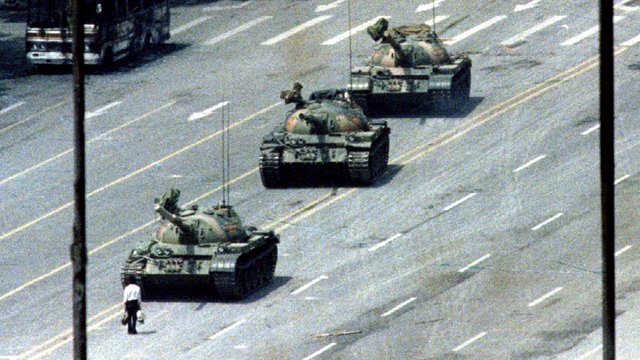
The 'Tank Man' image has got to be one of my all-time favorite liberty-themed images in history. This man's small, gentle, and single act of deviance, was captured and shared for the world to see for many years to come. It's inspiring and it's also frightening; to think about what became of that man after he decided to take a stand like he did that day. It's been well over 20 years since that day occurred, in Tiananmen Square, back on Jan 5th 1989.
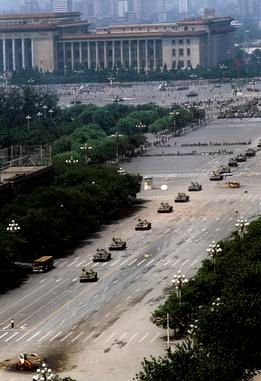
The Tiananmen Square Protests
The protests that took place prior to that eventful day, were said to have been student-led demonstrations and they are recorded as taking place from April 15th to June 4th 1989. Prior to the protests taking place, it's said that there was a growing undercurrent within the Chinese intellectual community, of individuals who saw authoritarian political systems as causing more harm than good. Some individuals, such as professors, even started to go on tours to teach about human rights, liberty, and so on. It's said that many students started to be attracted to the idea of political reform. Those who embraced such notions, were labeled by critics as ''worshiping'' Western lifestyles and values. But interest with the students was growing, if there was a possibility that they could make things better then they wanted to discuss the possibility surrounding that.
In the winter of 1986, students started to protest the slow pace of political reform. They were protesting a number of issues, such as topics like democracy and the rule of law. Although those protests were said to have started small, it didn't take long for them to spread and for more people to become engaged in the discussion. This was a big problem and growing worry with the authorities in power, after all it was their legitimacy which was being increasingly questioned by the students and the people.
The state is alleged to have accused the students of trying to spark some revolution-style turmoil in the country. And in early 1987, following propaganda campaigns that were aimed at cooling the protest rhetoric, the people saw a bit of calm restored.
Around the 15th of April in 1989, the students started gathering and protesting again. This was following the death of a well-known advocate of the controversial and inspiring views, he was astrophysics professor Fang Lizhi. After his death and the introduction of the protests, the students began making signs calling for attention to topics like corruption and freedom of the press. They started out as small gatherings but then it quickly grew to demonstrations of 500+ and then multiple thousands got involved and they congregated at Tiananmen Square (TS). By April 20th, many of the protesters had dispersed after confrontations with the police and for those who refused to disperse, the police are said to have pulled-out their batons. But by April 21st things started heating up again and it's estimated that 100,000 students marched on TS. Their act of civil disobedience blatantly ignored orders from the state. They continued protesting and became increasingly organized, and it's said that many of them even called for boycotts at Beijing Universities.

Then The Rioting Started...
It was all relatively peaceful up until around April 22, when riots started and cars were destroyed, along with houses, and there was a lot of looting and destruction to many shops. It's estimated that at least 38 stores were looted and about 350 people arrested over the matter. But despite the uptick in violence and chaos, the students pressed on with their protests, despite multiple calls from the state to disengage.
Premier Li Peng is said to have then told the General Secretary at the time, Zhao Ziyang, that he needed to get "more serious" with the protesters because it was obvious they weren't listening to the state's demands to disperse. After the General Secretary who had initially waved off the call to get “more serious” with the students, is said to have left for a meeting in North Korea, that left Li Peng in charge and able to act on executive authority. He had the power he needed in order to get “more serious” with the students, and he did. The state on April 26th issued state-sponsored propaganda that harshly labeled the students as an anti-government and anti-party revolt. Understandably, this editorial piece didn't please the students and sparked anger in many. So the propaganda didn't do what it was supposed to do in trying to scare the students to go back home, instead it just re-fueled the fire to sway them to continue with their protests.
By April 27th it's said that at least 50,000-100,000 students were involved in protesting in the streets and in Tiananmen Square. They forced their way right through police lines and are said to have received widespread support from the public. They tried to market their protest as being more pro-party, and instead focused on concerns of anti-corruption and anti-cronyism. It was then that the state started meeting with student representatives and it's alleged that they discussed a wide range of different issues, but they didn't come to any consensus on any issue. By this time the General Secretary at the time, Zhao Ziyang, had returned and he publicly labeled the student movement as being patriotic in nature and he said that there was legitimacy to their concerns about corruption.
He gave a few speeches in May and this satisfied many students, although there were thousands who still kept protesting in the streets. By early May, the majority of schools had announced an end to their class boycott and many of the students started to lose interest in the protest. But some of the students thought that the government was simply employing a trick to try and persuade the students into submission and to forget the matter. So they tried to re-engage interest by mobilizing for a hunger strike to begin around May 11th 1989.
The students gained a lot of support from the public over their hunger strike and it's said that on May 13th about 300,000 were gathered together in TS. This sparked interest elsewhere in the country and the protests started up once again, with daily marches taking place and again more calls for class boycotts. By May 17th an 18th it's estimated that at least 1 million people demonstrated along with the students in protesting. They had support coming from everywhere, police officers and low party officials, to the Chinese Red Cross sending in medical help and more. The Chinese government was under a lot of pressure to deal with this event in a civil manner and by this time protests were taking place in hundreds of cities around the country.
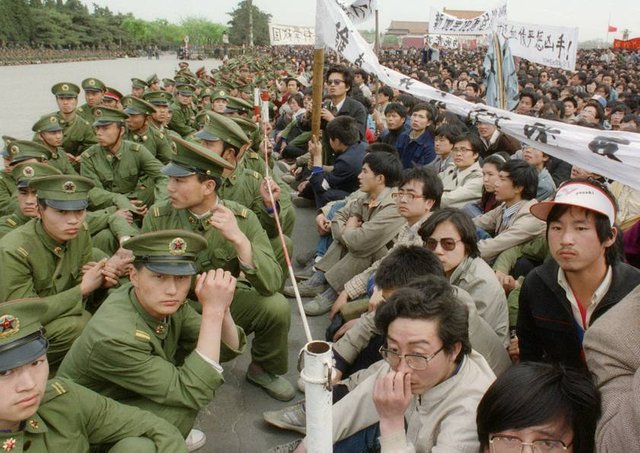
"Just Following Orders"
The state started to see its authority and legitimacy begin to erode in the face of growing support for the students. So by the end of May, the government responded in declaring martial law over the incident. It's reported that General Secretary Zhao couldn't lower himself to enact and carry out the martial law, so he instead sought to take leave and let someone else be responsible for unleashing the violence.
The Vice-chairman of the Central Military Commission then got ready to roll the military out into the capital.
On May 19th Zhao tried one final time to plead with the students to leave and go home, to end their hunger strike. He said that they were still young and he urged them not to sacrifice themselves over this matter. The crowd is said to have applauded his speech and that is also known as Zhao's last and final public appearance.
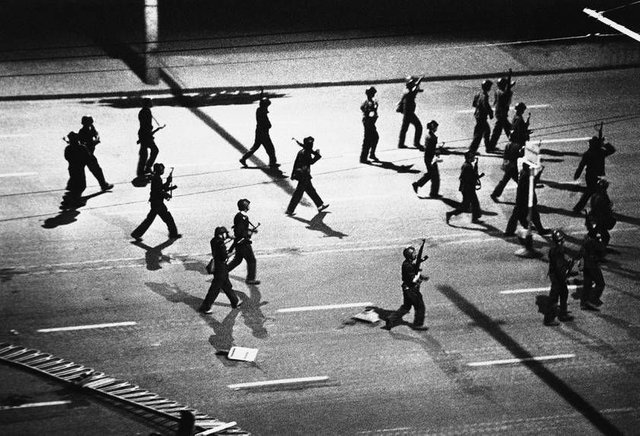
Martial law was officially declared on May 20th and at least 30 divisions of the military were mobilized. It's estimated that at least 250,000 troops were deployed in order to deal with some disgruntled students on a hunger strike. And Tank Man wasn't the only one who protested them that day, there were tens of thousands who are alleged to have surrounded military vehicles and tried to prevent them from entering the city or retreating.
The protesters started to persuade the military to join their cause and they even provided them with food, water, and shelter. This is then said to have prompted the authorities to withdraw on May 24th. It looked like it was a small victory for the protestors, but the military was only getting ready for its final assault that was about to take place.
On June 1st the state again sent out state-sponsored propaganda labeling the protesters as terrorists and counterrevolutionaries, and it tried to persuade political members of the need to “clear the square out.” Political members began to fear that the student protest had been infiltrated by “bourgeois liberalism” from the West and it prompted many to want to get on board with trying to justify the military action that was about to be used.
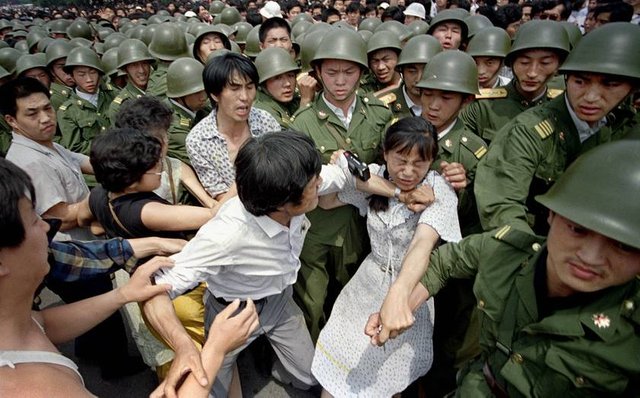
Admitting Defeat Of Their Intelligent Faculty
The plan was to clear the square by force. And human beings "just following orders" did it, they actually took the lives of many peaceful students. It's believed that the military might have started to advance on June 2nd, and this sparked outrage and worry with the students and others, who then quickly tried to set-up road blocks to prevent the military from getting to the square. The following morning, on June 3rd, students and residents found military members secretly trying to smuggle weapons into the city, as they were dressed in plain clothing. This then lead the students to protest right outside of the leadership compound and the police responded with tear gas.
The military then planned to clear-out the square in the middle of the night like a bunch of cowards so that their crimes would be under the cover of night. The plan was to have it cleared between 1am and 6am. That evening the state-sponsored television news programs had warned residents to stay inside, but many of them again took to the streets and tried to prevent the military from doing what it was about to do. It's recorded that about 10pm that evening, the military opened-fire on the protestors in a number of different places, including the square eventually. And throughout the night, news started to travel around about what was going on.
The public was outraged by what the military was doing, and they responded by attacking soldiers with rocks, sticks, and even molotov cocktails.
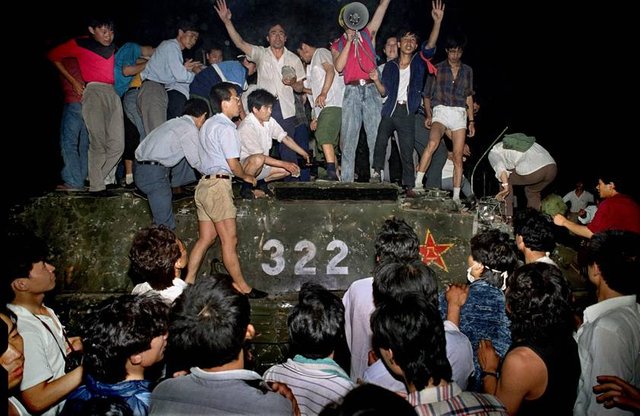
Then Comes Tank Man
On June 5th a lone man was photographed after he stopped in his tracks and decided to stand in front of a row of tanks that were leaving TS following the violence that had just occurred. Video footage shows that the Tank Man had tried to prevent the tank from moving as he would step in its way when the tank tried to go around him. He stood there defiantly for longer than most anyone would under those circumstances. He then climbed up onto the tank to try and speak to the soldiers who were inside of it, video footage then shows that he was pulled aside by a group of people and we don't know if he was ever seen again.
It's not known exactly how many died that day. Official estimates say several hundred, but those numbers are of course contested and some estimated that it could be upwards of 1,000, with thousands more who were injured, and even more than that who were likely arrested.
Of those who were arrested, many were eventually executed.
It is said that current access to information about this event is blocked and restricted by censors in China. The government there doesn't want its citizens to know what happened that day. And Chinese officials denied for quite some time that anyone ever lost their life in TS. The Tank Man image is arguably the biggest well-known symbol regarding that event.
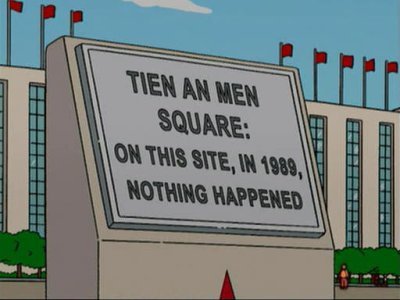
Below is a candle-light vigil being held in Hong Kong in 2014, commemorating the events that unfolded around TS, where it's estimated around 200,000 people attended. And that isn't the first one that has been held either, as there are many people not only in HK but around the world who are still passionate about remembering this event; perhaps in the hope that history won't repeat itself.
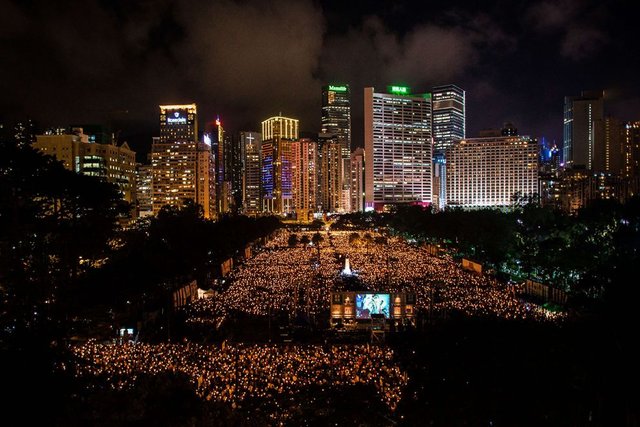
Pics:
Wikipedia
The Atlantic
Getty Images
AP
Philippe Lopez//AFP/Getty Images
Sources:
http://www.businessinsider.com/famous-tiananmen-square-tank-man-photograph-contact-sheet-anniversary-2-2015-6
https://en.wikipedia.org/wiki/Tiananmen_Square_protests_of_1989#Protest_development
https://mic.com/articles/166810/here-are-the-25-best-and-unforgettable-theme-show-songs-of-all-time#.JxyzxZmRj
https://www.nytimes.com/2014/06/04/world/asia/times-coverage-of-tiananmen-square-25-years-ago.html?_r=0
http://archive.boston.com/bigpicture/2014/06/25th_anniversary_of_the_tiananmen_square_mass.html
http://time.com/3908678/tiananmen-massacre-26th-anniversary-hong-kong-china-vigil-victoria-park/
Wow, I find myself deeply moved by your article... I was just a young boy when it happened and it had such a profound impact on me. I've always rooted for the underdogs and, in that case, the "Tank Man" surely was a hero and still is in my heart, my mind and my soul really.
Your article is a very important piece of our human history that so many would like to see disappear just like the history of the Holocaust, for it shows the ugliness of the regime where the insanity comes from and for which we always have to stand up, rise and fight against. Our freedom and liberties depend on it and, as history shows us, it is eventually and ultimately with the price of our blood that we gain sometimes end up taking a step toward a political state of freedom as communities, as countries and and human beings as a while.
Thanks you for your courage to share this quality piece of history for whom so many paid the ultimate price for. All for one and one for all! Namaste :)
I am very sorry to see these images, there is something annoying in over way is the abuses against hunmanidad, excellent post dear friend @doitvoluntarily congratulations thanks for sharing this beautiful post
Thank you for reminding us of this tragedy. Then I was a young man living in London in China Town.
Significant moment in history and we need more of this. Stand up for common lawful and inalienable rights and take teh power back away from the elitist clubs. Democracy and goverment is an illusion of freedom. It is juts an illegitimate business opportunity and we have all been deceived. Blue and Red are running for the same team.
I certainly do not have the gumption to stand in front of a line of military tanks. What a poignant moment in history. Thanks for sharing!
I was at a peace march in South Dakota who was a professor in china and that very man was his student. He was encouraging this protest and still himself was a marcher for peace and freedom. I could tell as he told the story he was very conflicted in his role of encouragement to this young man. No question a true hero.
You can watch the whole video. He stands there for about a minute then some people come up to him and tell him to get out of the way and then he just gets out of the way, not that inspiring really.